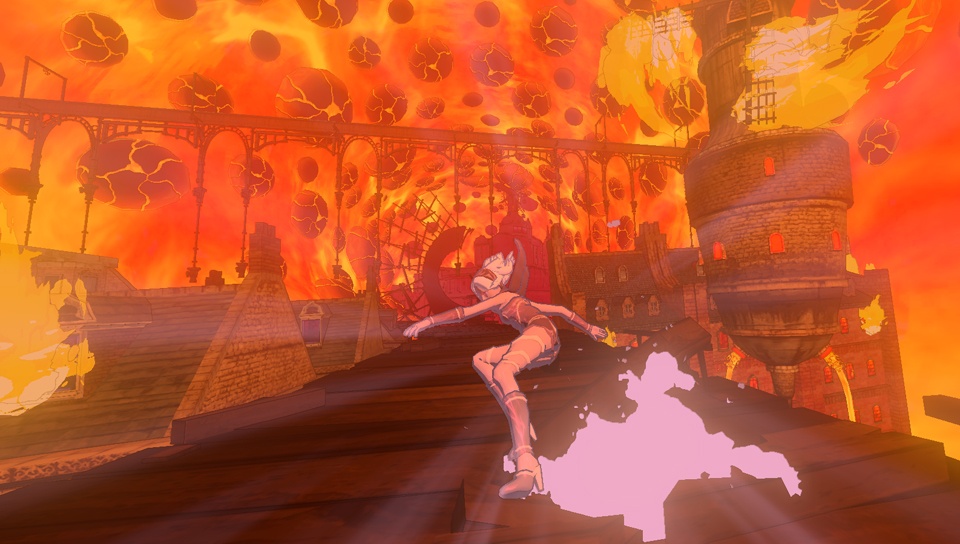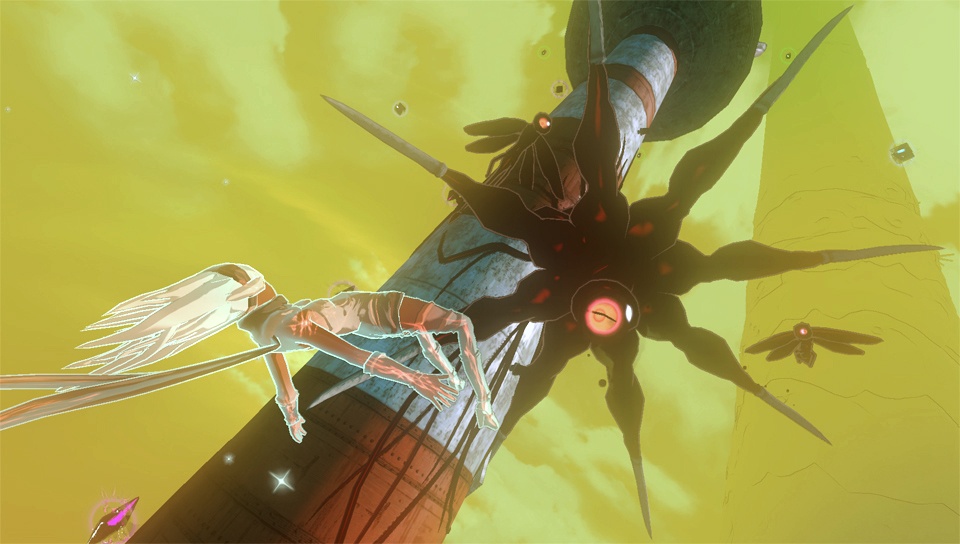Defying physics in Gravity Rush
We chat with the director of the upcoming Vita game about its sales state in Japan and Asia, the game's universe, and his future commitments.
PS Vita-exclusive adventure game Gravity Rush may not be out in Western markets until June, but the game has already been available in Japan and parts of Asia for several months now. The title has sold well so far, sailing past the 100,000-copies mark after its debut. We recently spoke to game director Keiichiro Toyama about his thoughts postrelease, his influences, and why Gravity Rush was switched from being a PS3 title to a Vita one.
GameSpot Asia: Among all the French comic artists and illustrators out there, you picked the late Jean Giraud's (aka Moebius) work as the main influence for Gravity Daze/Rush. What was it about his style that drew you to it for inspiration's sake?
Keiichiro Toyama: I was attracted by the man's extraordinary colour sense, the expansion of the space, and the feeling of floating in his artwork. The themes of realism, mysticism, futurism, and fantasy coexisting with each other also inspired me. These feelings are the things I kept in mind when I was young, so I was glad I could turn it into video game form. God rest his soul.

GSA: How did you recruit Kohei Tanaka for music duties? What was it about Tanaka's work that made him a fit for the project?
KT: While doing the project, I borrowed all sorts of animation styles back from the '70s when I was a kid. Kohei Tanaka was the only one who understood the concept of gorgeous-sounding orchestras that had easy-to-remember melodies, and he brought it back to our time. I'm thoroughly delighted with the end result; he didn't just meet my expectations, but also exceeded them.
GSA: With the game out already since February, how is the response both critically and financially?
KT: The title is highly praised by the local media for its novelty and challenges. I was worried about the lack of puzzle, but many users mentioned that it's still fun. The main character Kat is also very popular. We received a lot of feedback saying that players were sad to finish the game.
We have sold over 100,000 copies in Japan, and it's still going strong. We also have very good sales in Asia and great fanfare from the US and EU market. Since Vita sales are expected to continue to increase, I felt that we scored a hit.
GSA: What was the initial reason for the switch from the PS3 to PS Vita for Gravity Rush?
KT: I received the information of the Next Gen Portable (the Vita's codename at the time) during the process of producing the PS3 version, so that I could check out its capability. The compatibility between the gyro sensor and how the gravity action worked on the NGP made me decide to change the platform. It was hard to judge if the things that we were trying to do could be done on the NGP, because not all hardware specifications were confirmed at that moment.
The development environment was also under maintenance, so it was not an easy thing to bring about for all our staff, especially for our programmers. We made a version that could also run on Windows to overcome this issue. The best part was that we managed to create an innovative approach to realise a different dimension in the screen, utilising the Vita's portability.
GSA: The made-up language of Gravity Daze/Rush's world sounds very French. Was that your intention?
KT: That was indeed my intention. The language was inspired by Moebius and the concept of "bande dessinee" [term for drawn strips from France], and the fact that many Japanese dubbing on French movies felt, well, natural. We found it easy to forge that similar kind of atmosphere because of this.
GSA: After playing through the game, the common theme we're getting is "rebirth" and "rebuilding," as Kat is helping to rebuild the broken-down city piece by piece. Is that correct, or was there something else we're supposed to feel from the Gravity Rush experience?
KT: The major theme of this story is the growth of Kat. Her growth as a character and in the game represented the economic disparities and environmental issues in the real world. In the world of hierarchical structure, people from the lower class suffered from hardships and poverty. In contrast, people from the upper class were given first priority to their possessions and safety.
The story was centred on Kat, who had no place to call her own. She remained an honest and innocent face as she fought off the egos of the society. In reality, the world was on the brink of collapse, and the concept of "rebirth" would never happen. Hence, this is why Kat stands out.

GSA: Personally, the game can give players a bit of a headache, what with the gravity shifting and all. Early on during development, wasn't your team worried about how camera controls and camera angles would be handled on a game like this?
KT: It was a big concern, but it wasn't a major issue when it came to the display. I think this was due to the size of the screen and the overall hardware.
GSA: From a cost and production standpoint, was Gravity Rush expensive?
KT: It was a bit expensive, since we had to conduct Vita's basic research and environmental improvement at the same time. However, it was not that expensive compared to current AAA titles.
GSA: What are your thoughts and comments on the recent Silent Hill HD rerelease? There was word going around that it was ported poorly.
KT: I'm not going to make any comments about Silent Hill HD. I will say this: horror games use limitations of a console as an underhanded way to generate fear. This means that we need to think carefully on how to handle each element of the hardware that has rich power of expression. For example, having a clear view of the facial expressions in Siren will only turn users off. We took all these into account, and changed some expressions in Siren: Blood Curse.
GSA: Now with Gravity Rush done with in Japan and Asia, would you be planning on revisiting the Siren series, or doing something along the horror genre?
KT: Personally, I'm very interested in horror games, but it's getting hard to balance cost with effectiveness in this HD generation. Making the sequel to Siren might be difficult, but there is a possibility of just creating something new from scratch. At this point in time, however, there is nothing that I can promise at the moment, since we are now entirely devoted to Gravity Rush.
GSA: You were responsible for creating the lyrics to the in-game song "Jeuchalais Evule Plelat / You Will Die (So Don't Worry)." Since the words are based on a made-up language in the game, what is the song about?
KT: In the story, Kat lapsed into her own internal life and had to face her past. I handled the scenario for that scene by myself, so the lyrics are based after the scripts. I wrote the scenario and lyrics after we had a big earthquake last year; as a result, I felt that I was reacquainted myself with death. At the time, the project was not going well, and I became very frustrated.
Fallout 4 Next Gen Update Comparison Stellar Blade - Hard Mode No Damage Gigas Boss Gameplay Stellar Blade - Hard Mode No Damage Abaddon Boss Gameplay Stellar Blade - (Almost) All Outfits Granblue Fantasy: Relink - New Content Trailer Modern Warfare III - New Season 3 Reloaded Modern Warfare Zombies Update River City Girls 2 - New Playable Characters DLC Reveal!! That Time I Got Reincarnated as a Slime ISEKAI Chronicles – Official Announcement Trailer MEGATON MUSASHI W: WIRED – Official OP “MUSASHI English Ver.” Trailer Gothic 1 Remake | Official Collector's Edition Trailer SaGa Emerald Beyond – Official Launch Trailer Paper Mario: The Thousand-Year Door – Official Switch Overview Trailer
Please enter your date of birth to view this video
By clicking 'enter', you agree to GameSpot's
Terms of Use and Privacy Policy
However, I realized that one day we will die, and all worries will be gone. So why not enjoy the moment without thinking too much? Thus, I implemented that message into the song's lyrics.
The song is created by Kohei Tanaka with the image of my favourite song of Jane Birkin. I was worried about the lyrics, because it was something imaginary, but the recording actually went very well. Tanaka advised listeners to sing this song just like you are humming something in a bar. Honestly, I loved it.
GSA: Finally, what would you like to say to people who have played Gravity Rush in Japan and Asia?
KT: I would like to show my sincere gratitude to anyone who bought this game. Your cheers and praises provide further incentives for our team to keep on making these sort of games. We appreciate your continued support!
Got a news tip or want to contact us directly? Email news@gamespot.com
Join the conversation